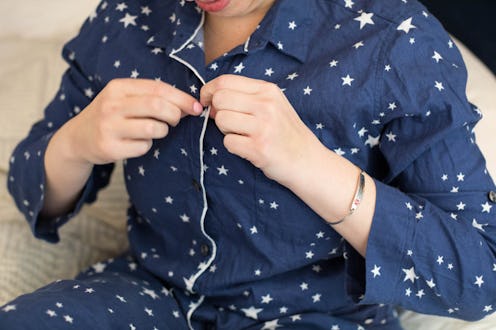Health
Doctors Explain What To Look For During A Breast Self-Exam
Plus, how often you should be ~feeling yourself~.

When's the last time you felt your breasts for lumps? It's a serious medical question; while breast cancer can show up with multiple symptoms, including unusual nipple discharge or swelling and pain, a lump in the breast tissue is one of the classic early warning symptoms. But if you've ever given yourself a breast self-exam, you might feel like breasts are like... kind of lumpy, anyway. Knowing what a lump in your breast is supposed to feel like — and how it's different from normal breast tissue — could save your life.
If you're not sure what to look for, don't panic. Everyone's breast tissue can feel different, since every body is different, but the more often you do a breast self-exam, the more familiar you'll be with your breasts' texture. "I usually tell patients, if they feel something new, something firm and hard like an almond or a walnut or just something that they did not notice before, then they should come in for a check up," says Dr. Adeeti Gupta, founder of Walk In GYN Care in New York City. Lumps can be painful or painless, according to the American Cancer Society, but if it feels "off" or different, it's worth bringing to your doctor's attention.
"A classic breast cancer lump is hard, roundish and sometimes difficult to move (also called fixed)," Dr. Marleen Meyers M.D.,a medical oncologist at NYU Langone Health and director of the Perlmutter Cancer Center Survivorship Program, tells Bustle. "There may be associated dimpling of the skin or rednessand sometimes the nipple may invert." Changes in the surface of your breast tend to be caused by a tumor becoming attached to the skin or nipple, Dr. Richard Reitherman M.D.,medical director of breast imaging at MemorialCare Breast Center, tells Bustle.
Not all cancerous lumps are hard as rocks, though. "Very importantly, a cancer can also be softer and more bumpy than a hard mass," Dr. Meyers says. "These cancers may be very difficult to find if a person has lumpy breasts." They come in different shapes, too. "A breast cancer is often irregular in shape," Dr. Crystal Fancher M.D., surgical breast oncologist at the Margie Petersen Breast Center at Providence Saint John's Health Center, tells Bustle. But the Dana-Farber Cancer Institute notes that breast cancer lumps can be evenly shaped, too. A new lump of any kind needs to be checked out.
Breast self-exams, along with mammograms, are crucial to detecting breast cancer earlier, which leads to better outcomes. According to the National Breast Cancer Foundation, people should self-examine their breasts at least once a month. If you're not sure how to do a breast self-examination, Dr. Gupta says the best time of the month to self-examine your breasts is during your period. You'll want to examine with the flat of your hand, and move clockwise on the breast while keeping your hand flat and applying slight pressure. Dr. Gupta also advises holding the side of your breast that you are examining upwards, and then repeat the process once you get to the other side.
Just because you find a lump while self-examining, it doesn't necessarily mean you have breast cancer. In fact, plenty of lumps are benign, according to the American Cancer Society. They could be cysts, fluid-filled sacs, or fibroadenomas, according to Johns Hopkins Medicine. But it's very difficult to tell what a lump really is without getting it checked out. "Any new lump should be investigated whether it feels hard or not," Dr. Meyers says. "The only way to know with certainty if a lump is cancer is with a biopsy." And catching breast cancer as quickly as possible is crucial. When cancer is detected very early and is still stage 1A (a cancer smaller than a peanut that hasn't spread anywhere), the five-year relative survival rate is 100%, according to the National Breast Cancer Foundation.
Bottom line: know your breasts. A lump is a lump, and if one turns up, you need to get it checked out ASAP.
Experts:
Dr. Adeeti Gupta, M.D.
Dr. Crystal Fancher M.D.
Dr. Marleen Meyers M.D.
Dr. Richard Reitherman M.D.
This article was originally published on